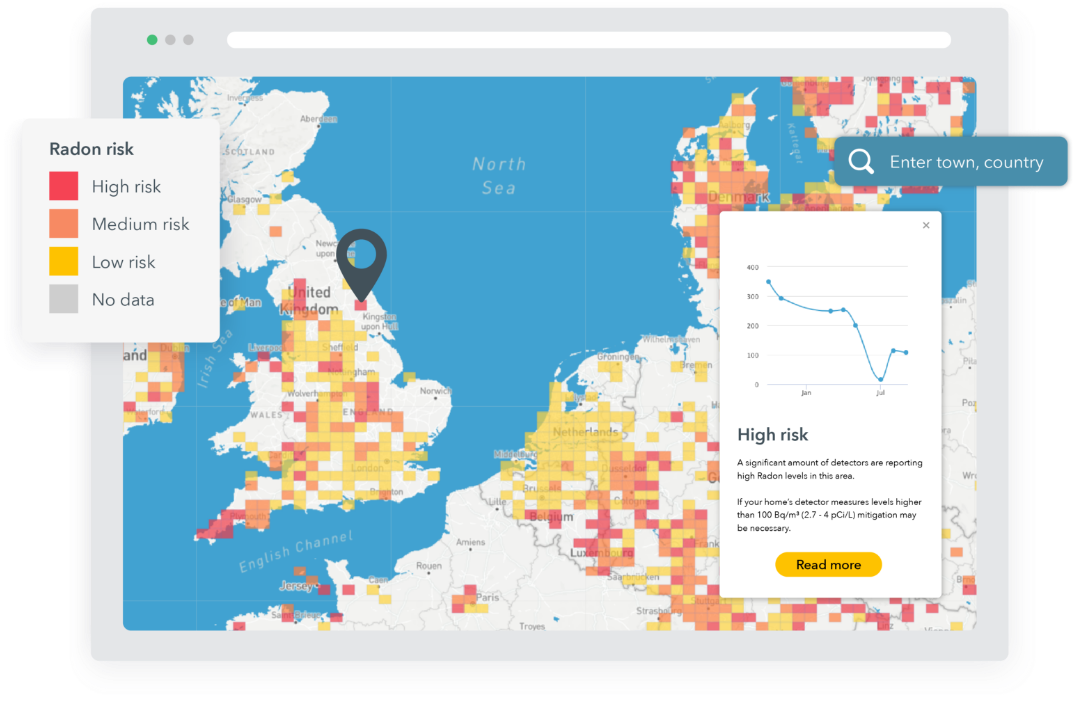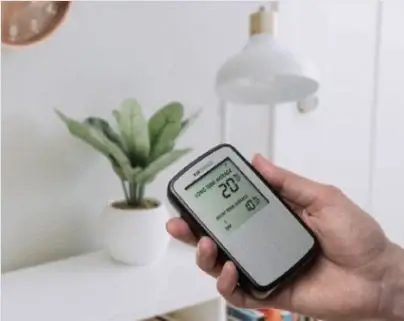What is radon?
Radon is a naturally occurring, invisible gas formed in the Earth’s crust.
Radon is found everywhere in the world. Outdoors, radon disperses harmlessly. However, indoors, it can accumulate to dangerous levels, especially inside modern, well-insulated buildings with limited ventilation.

Everything you need to know about radon
Why is radon dangerous to health?
Radon is a gas that, when released from the ground, breaks down into tiny radioactive particles known as radon progeny. These particles can become trapped in the lining of the lungs and emit radiation. This radiation can damage lung cells and cause genetic mutations, which may lead to lung cancer.
Radon is most dangerous when people are exposed to high levels over time. This is more likely to happen if radon levels are high inside the home or workplace, for example. Continuous radon monitoring is, therefore, critical for understanding your risk.
Causes of deaths in the USA per year according to the EPA
Radon / 21,000
Drunk Driving / 17,400
Falls in the home / 8,000
Drownings / 3,900
Home fires / 2,800
Where does radon come from?
The rocks and soil beneath our homes contain traces of uranium. Over time, the uranium breaks down and forms other elements. This is called radioactive decay. Radon is one element in the decay chain of uranium. When radon gas decays, it emits radiation in the form of an alpha particle. This radioactive particle is made up of two protons and two neutrons.
Why does radon cause lung cancer?
Radon progeny can attach to dust and other particles and be inhaled deep into the lungs. As radon and radon progeny in the air break down, they give off radiation that can damage the DNA inside the body’s cells.
All our cells contain DNA, which acts as an instruction manual or blueprint for cells on how to create copies of themselves. When an alpha particle hits our DNA it can cause damage to a cell’s blueprint. Cells constantly replicate themselves, but with a broken blueprint, which can be triggered by radon exposure, the replication process can become cancerous.
Radioactivity
Radioactivity takes different forms including alpha, beta, gamma, and neutron radiation, which have different capabilities to penetrate different substances.
X-ray sources
Gamma radiation is just high-energetic electromagnetic radiation (photons). We can ‘artificially’ create such high-energy radiation in an X-ray tube, in that case we refer to it as X-rays. X-rays are commonly used in medical scans like those performed in a CT scanner.
Internal tissue
The radioactive daughter products of radon (mainly polonium isotopes) can be inhaled and become lodged in the lungs. When these radon daughters decay by emitting alpha particles, these will damage cells due to the close proximity between the decaying isotope and the DNA material. Alpha particles cannot penetrate deeply and are much less damaging if the radioactive material that emits the alpha particle is on the outside of the body (for example on the skin).
Radioactive radiation
Artificial sources
When we think of radiation, we often think of artificial sources, such as X-ray or medical scans, but these sources have little effect.
Alpha radiation vs Gamma radiation
Alpha radiation (such as radon) has a much greater effect on DNA than gamma radiation. Imagine DNA being hit by a cannonball, that is what alpha radiation is like. Whereas gamma radiation is like the DNA being hit by a needle. There is a big difference in damage.
Why does radon build up indoors?
Modern buildings are often well insulated to save on energy bills. However, little airflow can allow radon to build up to high levels and cause long term exposure. Ventilation, which can be as simple as opening a window, is often the solution to keep radon levels safe. Monitoring radon continuously helps you know when radon levels are high and when to act accordingly.
Is radon a man-made problem?
The radon concentration within buildings is often much greater than outside. The gas comes from the ground and is captured and contained in our homes, resulting in levels that we seldom find in nature.
How does radon enter my home?
Radon rises and can enter a home or workplace through cracks in the foundation, entry points for pipes and more.
Will radon reach the top floors?
Some buildings have a higher radon level in the top floors. This can be due to artificial ventilation, natural updraft, or building materials used.
Does the weather affect radon levels?
Yes. Radon levels can be affected by natural sources such as cold weather, wind, pressure and shifting soil—even earthquakes and local construction.
Radonmap.com
Radonmap.com uses Airthings sensors from around the world to show live radon levels, broken down by location and anonymized. See the yearly and monthly approximate risk calculations in this easy-to-use, interactive map! Your neighbour could have different levels of radon to you, so it’s important to monitor your own home.
Who is at risk from radon?
Everyone is at risk of radon.
However, some are especially vulnerable.
All children are sensitive
Children’s organs are still developing
Their replicative tissue is more vulnerable to DNA damage.
Children weigh less
Their exposure is greater, as it is measured in concentration per kilogram.
Children breathe faster
They actually respire 2-3 times faster than adults as their lungs are much smaller.
Children have more life left
And thus could live long enough to get cancer from early life radon exposure.
“Radon is 10x more dangerous for children”
-Dr. Goodarzi presentation to Airthings 8th April 2019.
Why do radon levels change?
Radon levels fluctuate over time. That’s why it’s so important to measure continuously for as long as possible, to ensure your levels stay low.
The amount of radon emitted from the ground and the amount that actually enters our home can change due to the following reasons:
Temperature
Pressure
Humidity
Ventilation
Building insulation
Your home’s foundation
Snowfall
Ice
Rain
Earthquakes
Radon sampling: radon will not be distributed evenly around a room.
Imagine adding a dash of cream to a cup of black coffee but not stirring it. If you then take multiple samples from a small spot of that coffee for the level of cream, you would get very different readings over time as the cream slowly blends in with the coffee. Radon sampling works in the same way.
As a result, Airthings radon sensors give a short-term sample reading as well as an average long-term reading. This is why we recommend allowing your radon detector to measure for at least 30 days, so that the monitor can obtain enough air samples to provide a reliable long-term average.
What do my radon levels mean?
Good
0 - 1.3 pCi/LNo action needed.
1.4 - 2.6 pCi/LExperiment with ventilation and sealing cracks to reduce levels.
Fair
2.7 - 4.0 pCi/LKeep measuring. If levels are maintained for more than 3 months, contact a professional radon mitigator.
Poor
4.0 pCi/L and upKeep measuring. If levels are maintained for more than 1 month, contact a professional radon mitigator.












%20(1)%20(1).webp)

%20(1).webp)

%20(1).webp)